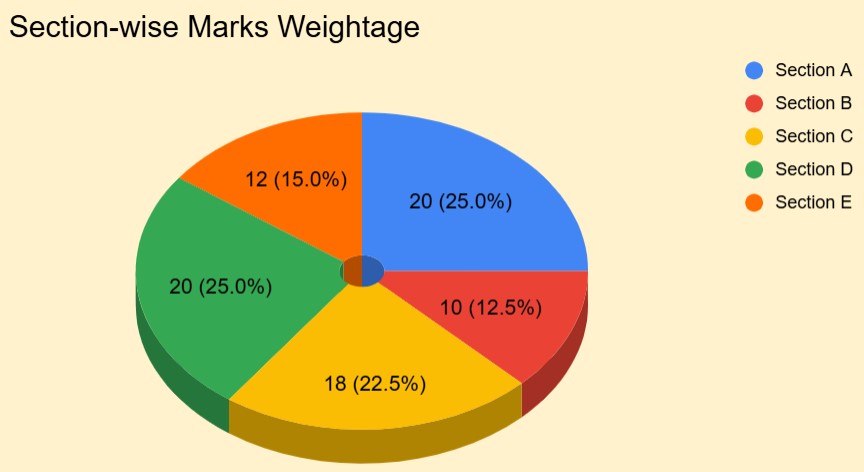CBSE Class 10 Maths Exam Pattern 2025: The CBSE Class 10 Maths Exam Pattern helps students understand the structure of the question paper, types of questions, and marking scheme. This makes it easier to plan preparation, manage time well, and focus on important topics to score higher marks. For the 2025-26 academic year, the Central Board of Secondary Education (CBSE) has released the Class 10 Maths exam pattern and marking scheme. According to the official paper design shared with the syllabus, the exam pattern and marking scheme will remain the same as in 2024-25. In this article, we explain the CBSE Class 10 Maths 2026 exam format, including question types, unit-wise weightage, and marking scheme in a simple way.
CBSE Class 10 Maths Question Paper Design 2025-26
CBSE has officially released the Class 10 Maths question paper design for the 2025–26 academic year along with the syllabus PDF. This year, the board has kept the same question paper design as last year. The internal choice rule also remains unchanged; there will be no overall choice in the question paper, but about 33% internal choices will be provided within all sections, just like the previous year's pattern. The following table shows the question paper design for years 2024-25 and 2025-26, including question Typology, total marks and weightage percentage.
|
S. No. |
Typology of Questions |
2024-25 | 2025-26 | ||
| Total Marks | % Weightage | Total Marks | % Weightage | ||
| 1 | Remembering: Exhibit memory of previously learned material by recalling facts, terms, basic concepts, and answers. Understanding: Demonstrate understanding of facts and ideas by organising, comparing, translating, and interpreting, giving descriptions, and stating main ideas |
60 | 75% | 60 | 75% |
| 2 | Applying: Solve problems in new situations by applying acquired knowledge, facts, techniques and rules in a different way. |
12 | 15% | 12 | 15% |
| 3 | Analysing: Examine and break information into parts by identifying motives or causes. Make inferences and find evidence to support generalizations Evaluating: Present and defend opinions by making judgments about information, validity of ideas, or quality of work based on a set of criteria. Creating: Compile information together in a different way by combining elements in a new pattern or proposing alternative solutions |
8 | 10% | 8 | 10% |
| Total | 80 | 100% | 80 | 100% | |
CBSE Class 10 Maths Exam 2025: Overview
The CBSE Class 10 Maths Exam 2025-26 is an important milestone for students' academic journey. Mathematics not only holds significant weight in board exams but also forms the foundation for higher studies in fields like engineering, economics, data science, and research. The Maths Paper tests students on a wide range of topics from units like Number Systems, Algebra, Coordinate Geometry, Geometry, Trigonometry, Mensuration and Statistics & Probability. Knowing the exam structure, syllabus, and marking scheme in advance helps students plan their preparation more effectively and score well. This overview provides key details about the Class 10 Maths exam for the academic year 2025-26. Check the overview of CBSE Class 10th Maths Exam 2025-26 given in the table below.
| Conducting Body | CBSE |
|---|---|
| Mode of Exam | Pen and Paper (Offline) |
| Duration | 3 hours |
| Marks | 80 |
| Total Number of Questions | 38 |
| Sections | 5 (A, B, C, D, and E) |
| Question Type | MCQs, A&R, VSA, SA, LA, Case Study-based Questions |
CBSE Class 10 Maths Paper Format 2025
The CBSE Class 10 Mathematics question paper is structured into different sections based on difficulty level and types of questions. The exam is divided into five sections and contains 38 questions. All questions are compulsory, with no overall choice. However, internal choices are available within specific sections. The detail CBSE Class 10 Maths Board Exam Pattern is given below:
| Section | Number of Ques | Marks/Qs | Total Marks | Type of Questions | Internal Choice |
|---|---|---|---|---|---|
| Section A (Q.1- Q.20) | 20 | 1 | 20 | MCQs, A&R | No |
| Section B (Q.21- Q.25) | 5 | 2 | 10 | VSA | 2 |
| Section C (Q.26- Q.31) | 6 | 3 | 18 | SA | 2 |
| Section D (Q.32- Q.35) | 4 | 5 | 20 | LA | 2 |
| Section E (Q.36- Q.38) | 3 | 4 | 12 | Case Study-based | 2 (In Subparts) |
CBSE Class 10 Maths Marking Scheme
The CBSE Class 10 Maths Board Exam Marking Scheme ensures a fair evaluation by incorporating stepwise marking for problem-solving questions. Below is the detailed section-wise marking distribution:
- Section A: 20 MCQs of 1 mark each
- Section B: 5 VSA Questions of 2 marks each
- Section C: 6 SA Questions of 3 marks each
- Section D: 4 LA Questions of 5 marks each
- Section E: 3 Case Study-based Questions of 4 marks each

Expert Tips to Prepare for CBSE Class 10 Maths Board Exam 2026
Preparing for the CBSE Class 10 Maths Board Exam 2026 requires a smart strategy along with consistent practice. Mathematics is a subject where clarity of concepts, accuracy, and speed play a major role in scoring well. Many students often feel stressed about lengthy problems and tricky case study questions, but with the right approach, it can become one of the most scoring subjects. Below, we are sharing the expert tips that will help you plan your preparation effectively, focus on important topics, manage time wisely, and build the confidence needed to excel in the exam.
- First of all, understand the syllabus and focus on high-weightage chapters.
- Practice previous year question papers and identify frequently asked questions.
- CBSE follows a step-marking pattern, so focus on writing solutions step by step.
- Allocate specific time for each section during practice.
- Solve past years' board papers within 3 hours to improve speed and accuracy.
- NCERT is the key resource for conceptual clarity so revise it thoroughly.
CBSE Class 10 Maths Syllabus 2025-26
The Central Board of Secondary Education (CBSE) has released the Maths Syllabus for Class 10 for the 2025-26 academic year. This Maths Syllabus outlines the course structure, chapters, and topics that students will need to study in the subject. The CBSE Class 10 Maths syllabus covers a wide range of topics, including Number Systems, Algebra, Coordinate Geometry, Geometry, Trigonometry, Mensuration and Statistics & Probability. It is divided into units with specific weightage, helping students plan their preparation effectively. The Class 10th Maths unite-wise chapters and weightage are provided below:
| Unit Name | Chapter Name | Weightage in Marks |
| Number Systems | Real Numbers | 6 |
|
Algebra |
Polynomials |
20 |
| Pair Of Linear Equations In Two Variables | ||
| Quadratic Equations | ||
| Arithmetic Progressions | ||
| Coordinate Geometry | Coordinate Geometry | 6 |
|
Geometry |
Triangles |
15 |
| Circles | ||
|
Trigonometry |
Introduction To Trigonometry |
12 |
| Trigonometric Identities | ||
| Heights And Distances | ||
|
Mensuration |
Areas Related To Circles |
10 |
| Surface Areas And Volumes | ||
|
Statistics And Probability |
Statistics |
11 |


